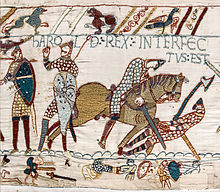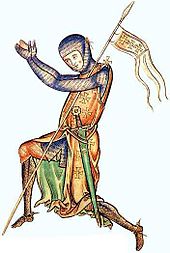Brünne
As Brünnen (also Brunnika , coat of mail and Haubert ) are different - partly by archaeological artifacts - assignable medieval designated body armor. A special form of the Brünne was the Helmbrünne , which was intended to protect the endangered head, neck and shoulder area of warriors , especially in the late Middle Ages .
Research history and time periods
Armament research in the 19th and early 20th centuries used the term "Brünne" as a collective term for various types of different armor forms, which most experts today reduce to the conventional ring armor (" chain mail ") and various types of scale armor .
Well representations in early sources

In the 13th and 14th centuries in particular, various methods were used to artistically depict medieval body armor. These mostly stylized types of representation have caused a lot of confusion up to the present day. In the past, the different artistic implementations were viewed as actual reproductions of different varieties. From today's perspective, this view can usually be clearly refuted, apart from a few cases of doubt. The numerous miniatures , drawings and sculptures from the High Middle Ages undoubtedly show, as a rule, conventional armored armor or armor.
In addition to the high medieval miniatures, the experts of the time particularly used the famous “ Bayeux Tapestry ” from the second half of the 11th century as a source for their interpretations. The armor shown is interpreted by modern research as conventional armored armor. The older armaments "translated" the strongly stylized images of the tapestry "literally" and developed in particular the idea of armor made of sewn-on rings. A fully functional fountain of this type was reconstructed by Karl Gimbel around 1900. This lay researcher also created two reconstructions of "leather-striped fountains" ( English banded mail ) based on medieval miniatures.
The question remains, however, whether the confusing different types of representation go back to actually existing special forms in the sense of older research. The creators of the countless book illustrations in particular apparently used templates from sample books, some of which could also be traced back to models ( icons , woodcuts ) from the orthodox culture. Various types and special forms of body armor were used there until the early modern times , which can be clearly identified and which have been preserved in original pieces. It is very likely here that such armor could have reached Western and Central Europe as a trade item or loot, for example as a result of the Crusades or Eastern colonization . For example, the well-known “kneeling crusader” from the Westminster Psalter by Matthew Paris (around 1250) wears lower leg protection derived from Byzantine or Middle Eastern forms of armor. The rest of the armor can be identified as regular ring armor.
The more recent research justifies its negative attitude mostly with the lack of corresponding archaeological evidence or original pieces. However, the preservation of such finds would be purely coincidental because of the transience of the organic carrier materials. The research of the 19th and early 20th centuries also assumed the existence of numerous special forms of the Brünne, as it was assumed that the technique of wire drawing was only developed in Europe in the course of the 14th century. Until then, conventional ring mail shirts were only affordable for very wealthy warriors. In fact, however, there is evidence that rational methods of making iron rings of armor were used as early as the early 11th century.
Representations of the wells in the early and high Middle Ages
The Teutons of Northern and Central Europe probably only took over the Ringbrünne from the Roman legionaries and auxiliary troops . Certainly, individual specimens of Celtic origin had already reached the Germanic culture as spoils of war or merchandise. The Celts had been using the ring armor since the late La Tène period .
The designation Serk, Sarwat , which can already be documented in the early Middle Ages , seems to point to an oriental origin of the mesh armor. In Persian zirih means tank shirt (see shirt ).
Before the 6th century AD, the mail shirt appears in the written sources only under its Latin name lorica . In the Leges Visigothorum , the protective weapon is then also named brunia or zaba, zava .
Also in the Anglo-Saxon heroic poem Beowulf, numerous mentions (serk) of the ring fountain show the use of this form of armor in early medieval northern Europe.
The early Germanic ring fountains seem to have been of varying quality. Gothic fountains in particular are described by chroniclers as not very resistant, while Franconian armor is said to have offered significantly more protection.
Jacob Grimm derived the term "Brünne" ( Old High German : prunia ) from brinnan (burn, shine). The word could therefore be traced back to the sparkling sheen of the armored rings of a relatively new armored shirt.
The derivation from the Celtic bruin (body) is currently preferred by the scientific community . According to a still widespread hypothesis , the Vikings are said to have "rediscovered" the ring armor well, largely forgotten in Northern and Central Europe, on their forays into Eastern Europe.
In addition to the ring armor, i.e. the chain mail, numerous types of scale armor were used up until the late Middle Ages , which were also referred to as the armor . The actual use of all these forms of armor can be proven by countless illustrations, but only a few, mostly fragmentary original finds. Of all the early medieval armored armored shirts, only the armored shirt of St. Wenceslaus in the Prague Cathedral Treasury (around 900 AD) has been almost completely preserved.
A badly corroded and clumped together armored shirt of the 11th / 12th centuries. Century could be recovered from the Polish Lednicki Lake ( Ostrów Lednicki ) ( Lednogóra, Muzeum Pierwszych Piastów na Lednicy , Inv.Nr MPP 93/99).
Fountain research in the 19th and early 20th centuries

According to the older researcher, the Brünne was a tank jacket made of padded canvas or leather. Century was worn by German and Franconian foot fighters and knights.
Iron rings, chains, metal plates or thick, riveted nail heads have been attached to sturdy fabric, leather , felt or loden since the High Middle Ages . The simple armor that was created in this way is said to have been used by less wealthy noblemen and warriors in particular until the late Middle Ages. Elaborate special shapes would have been made from armored rings or plates that were threaded onto leather strips or cords (leather-striped ring wells, English banded mail ).
In the absence of preserved original copies and corresponding archaeological finds, the ideas developed at that time must remain speculative so far. So far, only conventional ring mail shirts made of riveted or welded iron rings and numerous varieties of scale armor are clearly verifiable and recognized by modern research.
The riveted ring mesh, which was worn over a padded undergarment ( gambeson or doublet ), is regarded as the primary armor of the high medieval knight . From the 13th century on, body protection was reinforced with plate skirts , armor plates and rails. This development ended in the late Middle Ages in the closed plate armor .
The fountain was first in the form of a sleeved skirt or shirt with a hood that reached to the knees . In the late Middle Ages, the well only protected the endangered neck area of the warrior and was directly connected to the pool hood or helmet (helmet well). In Persia , similar armored collars were known under the name Gariban .
The fountain was used from the early Middle Ages until the end of the Middle Ages, in fact it is already mentioned in the Latinized form brunia in the capitularies of Charlemagne .
Brünnen from today's perspective
Despite the predominant rejection of the special forms of the Brünne described by modern specialist science, the older ideas are still widespread, especially in popular scientific literature.
Even in the catalog for the Bavarian State Exhibition Adel in Bavaria , published in 2008, the author of the article about the spectacular find of an 80 percent preserved rock plate in the area of the Hirschstein castle stalls in Lower Bavaria explains the armor in this way:
"Since the technical problem of a self-supporting flexible connection of the components of a harness was not yet solved at that time, the armored collar, the two shoulder pieces, the large breastplate and the three lap hoops with narrow spacing joints for better mobility could be placed on a vest or jacket made of solid material or made of leather. Possibly these metal parts were not visible, but covered with fabric. "
The great costume history tables of the 19th and early 20th centuries are often available again today as reprints . Some modern popular scientific images also take up the older interpretations.
Of the more recent, reputable specialist authors, only Francois Buttin assumed the actual existence of armor in the manner of banded mail . He believed to have found references to this variant (besogne quasiguesnée) in French written sources. In general, one now follows the opinion of FM Kelly and Claude Blaire, who considered all the various special forms of Brünne and other medieval body armor to be improbable.
See also
literature
- Wendelin Boeheim: Handbook of the armory. Reprint d. Ed. Leipzig 1890, Fourier Verlag, Wiesbaden 1985, ISBN 978-3-201-00257-8 , pp. 24, 25, 31, 33, 34, 41, 42, 49, 67, 129, 131, 132, 134, 135, 137, 138, 139, 140, 141, 164, 177, 215.
- Claude Blaire: European Armor circa 1066 to circa 1700 . London 1959.
- Francois Buttin: You costume militaire au Moyen Age et pendant la Renaissance . Barcelona 1971 (Memorias de la Real Academia de Buenas Letras de Barcelona, 12).
- Liliane and Fred Funcken: Historical weapons and armor . Munich 1980 (numerous later editions contain some controversial ideas from the 19th and early 20th centuries).
- Karl Gimbel: The Reconstruction of Gimbel's Weapons Collection . Berlin 1902.
- John Hewitt: Ancient armor and weapons in Europe . 3 vols. Oxford 1855/60.
- FM Kelly: Roman-Romanesque ring armor - your representation in simultaneous art . In: Journal for historical weapons and costume studies , 13 (new series, 4), Berlin 1923/34.
- Samuel R. Meyrick: A critical inquiry into ancient armor. London 1824.
- Niels M. Saxtorph: War costumes in colors. From the beginning of history to the 17th century . Berlin 1971.
- Eugène Viollet-le-Duc: Encyclopédie mediévale , 2 vols.Bayeux 1879.
Web links
Individual evidence
- ↑ Wolfgang Jahn (Ed.): Adel in Bayern - Knights, Counts, Industrial Barons (Catalog for the Bavarian State Exhibition 2008, April 26 to October 5, 2008 Hohenaschau Castle, Aschau i. Ch. / Lokschuppen Rosenheim Exhibition Center). House of Bavarian History, Augsburg 2008, ISBN 978-3-937974-19-4 , p. 39.



